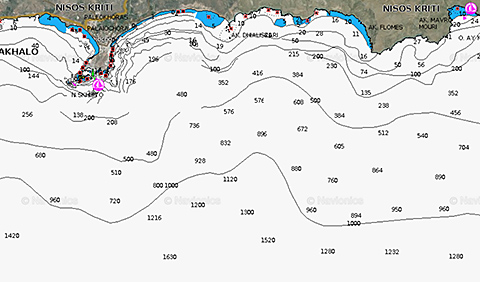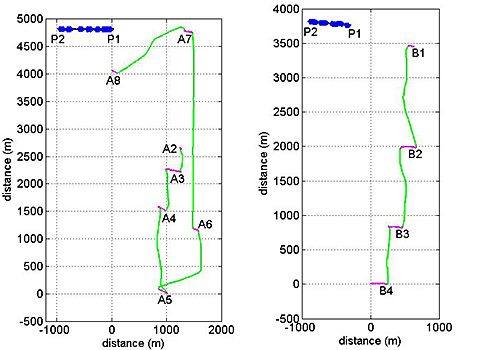RayLoc-2: Deep water Experiment
The deep sea experiments were carried out in the area between Paleohora and Sougia in the southwest of Crete. In this area the sea depth exceeds the 1,500 meters within a small distance from the shore which allowed the setting of the source of acoustic pulses at greater depths (500 meters to 1000 meters). It is also known that in this region often appear sperm whales and this was one of the reasons we selected this area hoping to record audio signals from sperm whales and to locate them. The following figure shows this area.The experiment was conducted in collaboration with the Institute of Cetacean Research PELAGOS. The RAYLOC 2 experiment was conducted at 6-12 June 2015

The main experiment was performed in 4 separate experiments named Rayloc2-A,Rayloc2-B,Rayloc2-C και Rayloc2-W (Sperm whale localization)
RayLoc2-Α Rayloc2-B
The RAYLOC_2A and RAYLOC_2B experiments aimed at detecting an underwater acoustic source located within the marine water column into a deep sea environment using two hydrophones. A pinger was used as a source at the depth of 1000 meters for the RAYLOC_2A experiment and 500 meters for the RAYLOC_2B experiment. Both experiments were performed on 6/6/2015.At the following pictures you can see in green color the routes of the boat (the Left is for experiment Rayloc2-A and the right for Rayloc2-B) .With blue color you can see the pinger and with purple the stations where measurements were made

RayLoc2-C
The RAYLOC_2C experiment aimed at detecting underwater acoustic source with a known depth in the deep sea environment using a single hydrophone. A pinger was used as a source at the depth of 1000 meters. The experiment took place on June 7 2015.At the following picture you can see with green color the path followed by the boat. With blue color you can see the position of the pinger and with purple the stations where measurements were made

RayLoc2-W
The RAYLOC_2W experiment aimed at detecting and locate sperm whales using two hydrophones. The experiment was conducted on 4 different days and the experiments of each day were named RAYLOC2-W1, RAYLOC2-W2, RAYLOC2-W3, and RAYLOC-2W4. The experiments were carried out at 7, 8, 9 and 12 of June respectively. The first two days sperm whales were detected and located and their signals where recorded. The next two days sperm whales were not detected in the area. On the 10th and 11th of June was not possible to conduct experiments due to deterioration of the weather.
At the following pictures you can see the two sperm whales that were located.






